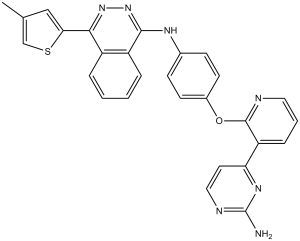AMG-900
This product is for research use only, not for human use. We do not sell to patients.

For small sizes, please check our retail website as below: www.invivochem.com
| Size | Price | Stock |
|---|---|---|
| 250mg | $890 | Check With Us |
| 500mg | $1450 | Check With Us |
| 1g | $2175 | Check With Us |
Cat #: V0365 CAS #: 945595-80-2 Purity ≥ 98%
Description: AMG 900 (AMG-900), a phtha-lazinamine compound, is a novel and ATP-competitive pan-Aurora (A/B/C) kinase inhibitor with potential antitumor activity.
Top Publications Citing Invivochem Products
Publications Citing InvivoChem Products
Product Promise

- Physicochemical and Storage Information
- Protocol
- Related Biological Data
- Stock Solution Preparation
- Quality Control Documentation
| Molecular Weight (MW) | 503.58 |
|---|---|
| Molecular Formula | C28H21N7OS |
| CAS No. | 945595-80-2 |
| Storage | -20℃ for 3 years in powder formr |
| -80℃ for 2 years in solvent | |
| Solubility In Vitro | DMSO: 100 mg/mL (198.6 mM)r |
| Water: <1 mg/mLr | |
| Ethanol: <1 mg/mL | |
| Solubility In Vivo | 1% DMSO+30% polyethylene glycol+1% Tween 80: ~20 mg/mL |
| SMILES Code | CC1=CSC(C2=NN=C(NC3=CC=C(OC4=NC=CC=C4C5=NC(N)=NC=C5)C=C3)C6=C2C=CC=C6)=C1 |
| Synonyms | AMG-900; AMG 900; AMG900 |
| Protocol | In Vitro | AMG 900 inhibits the enzyme activity of all 3 aurora kinase family members with IC50 values of 5 nM or less. In HeLa cells, AMG 900 inhibits autophosphorylation of aurora-A and -B in a concentration-dependent manner. Treatment of HCT116 cells with 50 nM of AMG 900 for 48 hours resulted in polyploidy and suppresses the formation of colonies after cell replating. AMG 900 inhibits cell proliferation, with EC50 values ranging from 0.7 to 5.3 nM. Importantly, 4 of these AMG 900-sensitive cell lines (HCT-15, MES-SA-Dx5, 769P, and SNU449) are resistant to paclitaxel and other anticancer agents. AMG 900 inhibits p-histone H3 or induced polyploidy across all the cell lines tested irrespective of P-gp or BCRP status with uniform potency (IC50 or EC50 values ranging from 2 to 3 nM). |
|---|---|---|
| In Vivo | AMG 900 exhibits significant antitumor activity in all 9 xenograft models tested (50%-97% TGI compared with the vehicle-treated control group, P<0.005, P<0.0005). Importantly, AMG 900 is active in the MES-SA-Dx5 (84% TGI, P<0.0001) and NCI-H460-PTX (66% TGI, P<0.0001) xenograft models that are resistant to either Docetaxel or Paclitaxel administered at their respective maximum tolerated doses. AMG 900 inhibits the activity of aurora-B in HCT116 tumors and suppresses the growth of multiple xenografts that represent diverse tumor types. |
These protocols are for reference only. InvivoChem does not
independently validate these methods.
| Solvent volume to be added | Mass (the weight of a compound) | |||
|---|---|---|---|---|
| Mother liquor concentration | 1mg | 5mg | 10mg | 20mg |
| 1mM | 1.9858 mL | 9.9289 mL | 19.8578 mL | 39.7156 mL |
| 5mM | 0.3972 mL | 1.9858 mL | 3.9716 mL | 7.9431 mL |
| 10mM | 0.1986 mL | 0.9929 mL | 1.9858 mL | 3.9716 mL |
| 20mM | 0.0993 mL | 0.4964 mL | 0.9929 mL | 1.9858 mL |
The molarity calculator equation
Mass(g) = Concentration(mol/L) × Volume(L) × Molecular Weight(g/mol)
Mass
=
Concentration
×
Volume
×
Molecular Weight*
The dilution calculator equation
Concentration(start)
×
Volume(start)
=
Concentration(final)
×
Volume(final)
This equation is commonly abbreviated as: C1 V1 = C2 V2
Concentration(start)
C1
×
Volume(start)
V1
=
Concentration(final)
C2
×
Volume(final)
V2
Step One: Enter information below
Dosage mg/kg
Average weight of animals g
Dosing volume per animal µL
Number of animals
Step Two: Enter the in vivo formulation
%DMSO
+
%
+
%Tween 80
+
%ddH2O
Calculation Results:
Working concentration:
mg/ml;
Method for preparing DMSO master liquid:
mg
drug pre-dissolved in
µL
DMSO(Master liquid concentration
mg/mL)
,Please contact us first if the concentration exceeds the DMSO solubility of the batch of drug.
Method for preparing in vivo formulation:
Take
µL
DMSO master liquid, next add
µL
PEG300, mix and clarify, next add
µL
Tween 80,mix and clarify, next add
µL
ddH2O,mix and clarify.
Note:
- (1) Please be sure that the solution is clear before the addition of next solvent. Dissolution methods like vortex, ultrasound or warming and heat may be used to aid dissolving.
- (2) Be sure to add the solvent(s) in order.




































